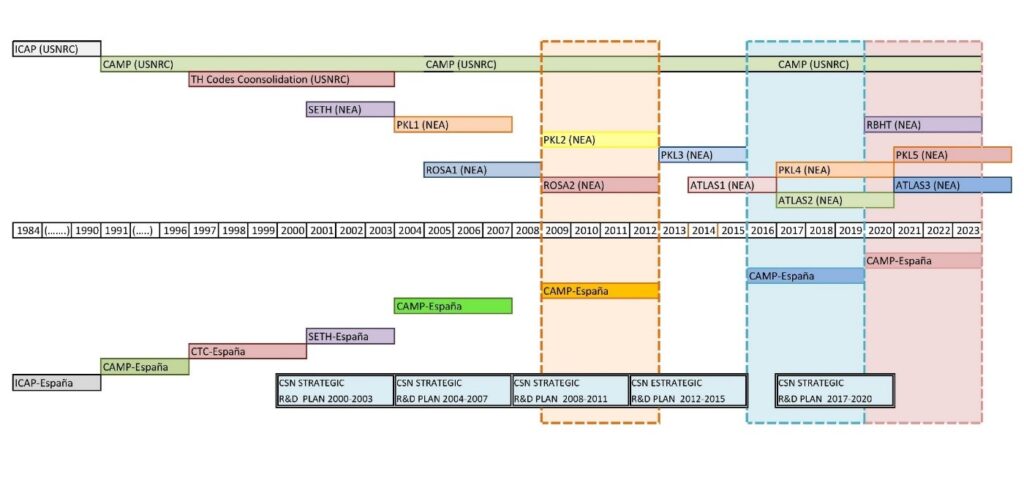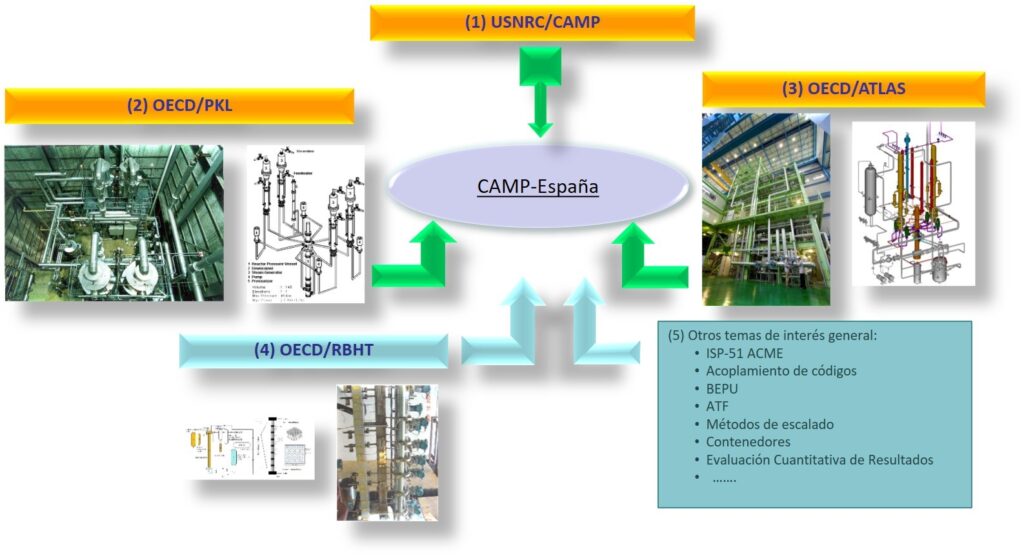Aiming at better tracking and explotaition of these programs and at making emphasis in the analysis of the applicability of the results to the Spanish NPPs, the CSN has promoted the participation of all the interested spanish stakeholders. All of the above has been channeled through the so-called CAMP – España program, which currently comprises the efforts of the Spanish NPPs, 4 Spanish engineering firms, linked to the nuclear sector (Empresarios Agrupados, Tecnatom, IDOM, NFQ) and 6 groups from national universities UPM, UPV and UPC, and the CSN. This program has a long tradition in the Spanish nuclear industry, having been continuously active since the 90s decade (see fig. 4).

Fig. 4. Schedule of the successive CAMP – España programs and their precursors
All of the above has been formalized through various collaborative agreements with:
- Technical Universities of Madrid (UPM, Mining Engineering Schools and Industrial Engineering Schools), Catalunya (UPC) and València (UPV)
- Engineering firms: Tecnatom, IDOM, Empresarios Agrupados and NFQ,
- and nuclear power plants.
STRUCTURE
- 6 university groups:
- Technical University of Catalonia (UPC-DFEN)
- Technical University of Madrid (UPM-DEC y UPM-DIE)
- Technical University of Valencia (UPV-DIQN; 3 grupos)
- NPP owners Working groups
- TECNATOM, IDOM, EEAA and NFQ Working groups
- CSN Working group
A Coordination Committee that meets bianually, with representatives from all the participant organizations, aims at:
- Reviewing and approving an anual working plan
- Reviewing and approving activities and documents (e.g., project reports, NUREG/IA);
- Organizing technical meetings (CAMP-España Technical Workshops); and
- Interacting with the different groups from the international projects (PRG/MB, benchmarks, workshops, counterparts, ….)
MAIN CONTRIBUTIONS
Each of the above referred agreements between CSN and each participating organization identifies the main contributions, which are driven by their different interests and capabilities. Most of these contributions (the ones that are intended to be documented through a NUREG/IA USNRC report) have been accepted by the Technical Program Committee (TPC) of the CAMP-International program.
Main current contributions include (see figure 5):
- PKL and ATLAS Pre-test and post-test calculations.
- Involvement in benchmark (PKL, ATLAS and RBHT) exercises and NEA workshops.
- Analysis of the applicability and/or extension of the results and knowledge, to the safety, operation or availability of the Spanish Nuclear Power Plants.
- Analysis of ATF fuel designs.
- Involvement in ISP (International Standard Problem), from NEA. There is currently an ISP proposed in the ACME (Advanced Core-cooling Mechanism Experiment) facility.
- Validation of the VESSEL 3D component in TRACE.
- Improvements and Applications of BEPU Methodologies.
- Improvements and Applications of Scaling Techniques.
- Code Coupling.
- PARCS (TRACE–PARCS, RELAP5-PARCS). Validation, Evaluation and Application.
- Analysis of accidents in spent fuel pools.
- Cask analysis.
- Comparison of TRACE and RELAP5 models and capabilities, including comparison of the results.
- Comparison of TRACE and TRAC/BF1 models and capabilities, including comparison of the results.
- Development of user and documents of good practices in modelling, applicable to certain families of scenarios and transients.
- Activities in SNAP
- Safety analyses for SMR reactors.

Fig. 5. Outline of the CAMP – España activities
- Involvement in ISP exercises from NEA.
- Integration of TRACE code in ditributed simulation environments, with the purpose of evaluating TRACE coupling capabilities in complex and heterogeneous simulation environments through the ECI module, and application to full scope simulators.
- Evaluation of the real transient in a plant with natural circulation after a Loss Of Offsite Power (LOOP) with RELAP5/MOD 3.2.
- Evaluation of the TRACE code capabilities for calculating the hydraulic loads in the pipes during transients.
- Analysis of a trial of control rod drop at the Trillo NPP, with the coupled code TRACE/PARCS, with the purpose of evaluating the development of a model for rod displacement done with the code PARCS. In this project, CNAT is collaborating with the UPV.
- Comparison of boron transport models in RELAP5, TRACE and TRAC/B, performed within a Iberdrola-UPV collaboration.
- Evaluation and application of the TRACE/CONTAIN coupling, performed jointly by CNAT and UPV.
- Analysis of accident management measures in accidents of loss of RHRS during a cold shutdown in a Westinghouse NPP, jointly performed by ANAV and UPV.
- Evaluation of TRACE in simulating a real transient of trip of the main pumps at the nuclear reactor Almaraz I, in collaboration with the UPM.
- Evaluation of the coupling RELAP/PARCS with a simulation of a real transient of cooling at Trillo NPP, performed in collaboration with the UPV.
- Sensitivity analysis of a 6” LOCA at Ascó NPP with RELAP5/MOD3.2, performed in collaboration with the UPC.
- Development of a model for TRACE of the Vandellòs II reactor and its application to a real transient of loss and a subsequent restart of the main cooling water pumps, performed in collaboration with the UPC.
CONTRIBUTIONS TO CAMP USNRC
The CSN-USNRC agreements oblige its members to prepare two codes evaluation reports –or documents with an equivalent value-, that comply with a certain level of quality and content as defined in the NUREG-1271.
- http://www.nrc.gov/reading-rm/doc-collections/nuregs/agreement/ Here is gathered the complete list of international contributions. Throughout the last phases of CAMP-España, the USNRC has published 41 NUREG/IA which have been produced by various Spanish entities (universities, nuclear plants, CSN, engineering firms…) that are provided in the annexes tables of this document.
- In the annexes tables of this document is present the list of the current Spanish in-kind contribution set with 19 new code assessments, which was approved by the CAMP TPC at the 2019 CAMP international meeting held at the premises of the UPV in Valencia.